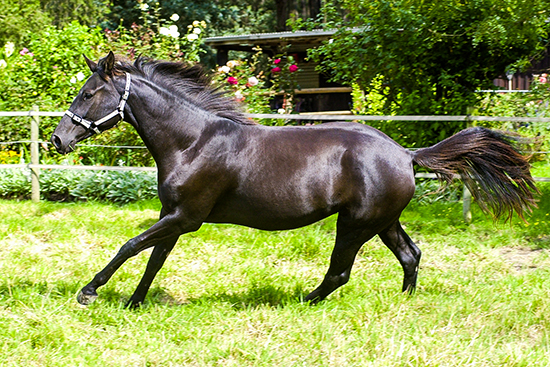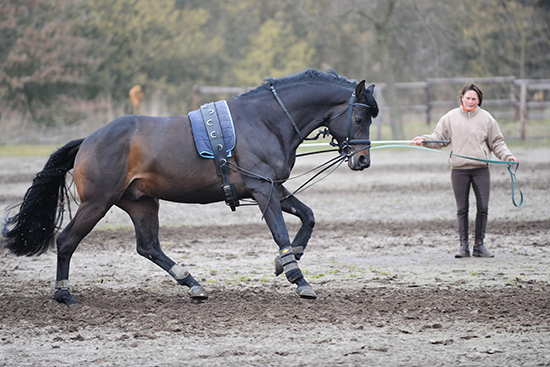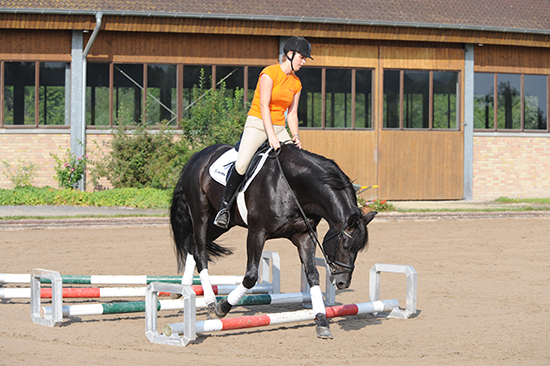Which treatments really work – Professor Leo Jeffcott and Dr Robin Bell look at the range of treatments for the horse’s back, and finds that some work – but some don’t work at all… and lots have never been properly assessed.
There are many treatments used to treat problems of the spine (thoracolumbar) in horses (table 1).
Many of these are used in combination, either at the same time or concurrently (e.g. rest, medical treatment plus some form of physiotherapy). To date there are few therapies that have been objectively assessed for efficacy and some of the therapies listed in this article are used simply as placebos. This lack of data leads to therapies becoming fashionable with owners and trainers. For example a few years ago it was very popular to request surgery for back problems, then swimming became popular, followed by manipulative therapy. It looks now as if the trend for the future may well be in natural medicine (i.e. acupuncture and laser techniques). Many of these therapies are performed by non-veterinarians; some are qualified physiotherapists, but a considerable proportion are not.
REST
For most types of thoracolumbar complaint a period of rest usually proves to be all that is necessary. Many of the earlier veterinary practitioners and farriers advocated rest as the most effective remedy for back troubles. In some animals the addition of some form of physiotherapy may be beneficial and in others the periodic use of anti-inflammatory medication is indicated.
For horses with injuries to the muscles and ligaments of their back, rest in a loose box is recommended until the signs of acute pain have subsided. After this the animal is turned out in a small paddock for a period ranging from one to twelve months depending on the site and severity of the injury. Often no other specific therapy is needed, but a gradual return to exercise is always advisable and the application of heat by way of an infra-red lamp is sometimes reported to be of benefit in the acute stage of muscle strain or for other soft tissue injury of the back. 
A period of rest usually proves to be all that is necessary
MANAGEMENT
The general management of a horse with a potential back problem is very important. Many “backy” horses have a temperamental or psychological component to the clinical picture, in particular those with a “cold back”. The use of a sheepskin numnah is frequently found to be beneficial, another practice is to give the horse a short period of lunging after it has been tacked up and before it is mounted.
A change of stable routine, and the type of work, often seem to be beneficial and this can involve a re-schooling or changing the type of exercise for a period in an attempt to renew enthusiasm for work (e.g. by sending the horse hacking or swimming). Often a change of tack, with the use of a lighter or better fitting saddle, can be of substantial benefit.
Once it has been decided to return the horse to work a graduated program of exercise is indicated, starting with ground work, and lunging to build up the back muscles and improve the animal’s suppleness. In this regard the use of a chambon to lower the head and neck during lunging can be very helpful. Also massage or gentle strapping of the back muscles after exercising is a useful procedure in horses convalescing from a thoracolumbar disorder.
MEDICAL TREATMENT
In horses with acute or severe back pain (e.g. fractured spinous processes of the withers) injectable analgesic medication is indicated for the first few days. This may be followed by oral nonsteroidal anti-inflammatory drugs (NSAIDs) such as phenylbutazone, flunixin meglumine, naproxen, meclofenamic acid and orgotein. These drugs may be administered when the horse is really uncomfortable. After this initial treatment the horse should be rested and further NSAIDs given once the horse returns to work. In acute cases, muscle relaxants such as dantrolene and methocarbamol may be useful as a 3–4 day course to relieve muscle spasm. Long-term therapy with any of these drugs is contra-indicated.
Local injection of long acting corticosteroids into the interspinous spaces in cases of overriding spinous processes has been used quite successfully by some practitioners. The practice of injecting sclerosing agents between the spinous processes and into the central sacroiliac ligaments has been used with mixed results.
PHYSIOTHERAPY
The application of heat by various means has been used for acute back injuries for many years, although whether they hold any real advantage over rest and medication is equivocal. Good results have been reported for various methods of physiotherapy such as faradic (ELECTRICAL) stimulation of muscles, shortwave diathermy and ultrasonic therapy. Deep massage cyclotherapy (Equissage) has been used, particularly in the United States and more recently therapy by swimming has been advocated. Recently other techniques such as pulsed high frequency electromagnetic energy and magnetic field therapy are being used for soft tissue injuries. Another modality that is becoming increasingly popular is the use of shockwave therapy for chronic back problems including osteoarthritis. However, no controlled trials on the benefits of these lines of physiotherapy compared with rest, or no treatment, have been performed.
Lunging is an excellent way to encourage the horse to use its back and topline as part of a rehabilitation program for back problems, with the careful use of a chambon, running side reins, or something similar
MANIPULATIVE THERAPY
This line of therapy, which includes chiropractic and osteopathy, is now routinely performed throughout the world. It is reported to give an immediate but transient relief to horses with back injuries. However, few critical or controlled trials of its efficacy nor the exact mode of its action have yet been published. This technique is performed with the horse either standing or under general anaesthesia. A thorough knowledge of equine vertebral anatomy, biomechanics and pathology is required to understand the principles and theories behind chiropractic evaluation, and to apply its techniques properly. Chiropractic provides additional diagnostic and therapeutic means that may help equine practitioners to identify and treat back problems. Specialised training in the evaluation and treatment of vertebral joint dysfunction and neuromusculoskeletal disorders place chiropractic in the forefront of conservative treatment of spinal related disorders. However, limited research is currently available on equine chiropractic in veterinary medicine. The future of equine chiropractic is dependent on formal research into the clinical effects of chiropractic techniques and the basic pathophysiology of spine-related disorders in the horse.
NATURAL THERAPIES
Methods of natural or “fringe” medicine are becoming increasingly popular to treat horses with back problems. Acupuncture has been investigated quite extensively in the United States and responses to its use have been reported. These workers concluded that the technique did work, but that correct diagnosis and proper judgement of treatment application were essential for effective acupuncture therapy. More recently the use of lasers are being introduced to produce the same sort of beneficial effect.
One other line of treatment, which appears to have no veterinary basis at all, is that referred to as radionics, or the so-called “black box”. This technique involves sending a hair from the mane of the patient to the operator of the black box. The hair is placed in the box and then it is claimed that an exact diagnosis can be made and the horse can be put on to treatment at the same time. It is hard to envisage how this technique can have any medical or scientific foundation, although there are a number of proponents in the UK and USA who claim beneficial results.
As the horse progresses through the rehabilitation programme, the judicious use of training aids such as cavalletti are an excellent means of encouraging the horse to optimise it’s performance.
SURGERY
Surgical resection of part of the summits of dorsal spinous processes of the thoracolumbar spine was first described for crowding and overriding to relieve pain and thereby eliminate the associated lameness. The technique was originally performed on 9 cases with encouraging results. Since then a number of modifications for this technique have been described. However, as explained below in the next section, now that we have a better understanding of the causes of kissing spines conservative management is more commonly used to treat this problem.
OUTCOME AND PROGNOSIS
There are few reports describing follow-up studies of back injuries or the efficacy of treatment regimes. Laser acupuncture was used as the sole treatment in 14 horses with chronic back pain, and 64% were still improved one year later. In the series published by the one of the authors of this paper (Professor Jeffcott), there were 190 horses with a chronic back pain complaint from which clinical follow-up information was obtained. Some 57% recovered completely irrespective of the diagnosis and treatment given, and in only 17% there was no improvement shown at all. The most common regimen of treatment for all 190 cases was rest and in only 11% was some form of physiotherapy given. This was chiefly in the form of faradic treatment, although swimming was successful in some cases. The highest recovery rate was in those cases with no identifiable vertebral lesions. There was also a low rate of recurrence recorded in these animals. The highest incidence of recurrence was in horses with spondylosis (91% ) despite their receiving anti-inflammatory medication and few (9%) ever returned to full work .
For the condition of kissing spines (overriding of the dorsal spinous processes) a comparison of the outcome of surgical and conservative treatment was carried out.
The overall recovery rates of these two groups of cases was very similar (approximately 60% fully recovered). The surgical cases, which generally comprised the more severely affected horses, tended to make better progress and a greater percentage returned to full work in this group. However, it should not be forgotten that they all received 4-6 months rest after surgery and this was the principal mode of treatment used in the medical group. There was also a higher incidence of recurrence of back trouble in the surgical group. It would appear therefore that surgical treatment for kissing spines frequently does not provide any major advantage over the conservative approach to therapy. The cases that showed the best response to surgery were those in which only one or two spinous processes were resected. In these horses the overriding was confined to just two or three summits and did not extend from the mid-back to the lumbar region.
CONCLUSIONS
Back problems are clearly an occupational hazard in both racing and performance horses. The conditions that may result are often difficult to diagnose accurately, but it is worth remembering that: Some horses can perform badly without having a back problem; Horses can perform adequately in spite of having a back problem; Spontaneous recovery from many types of back problem is quite common.
Finally, the simple recourse to a period of rest followed by a graduated exercise programme is all that is required in many cases. This can often be supplemented by various techniques of physiotherapy. Surgical intervention should be limited to resection of kissing spines in selected cases where the diagnosis has been confirmed by radiological examination and local anaesthesia of interspinous spaces. Further studies on the biomechanics of the vertebral column and pathology of thoracolumbar injuries are essential to better understand pathogenesis and from this sounder principles of therapy can be established.





